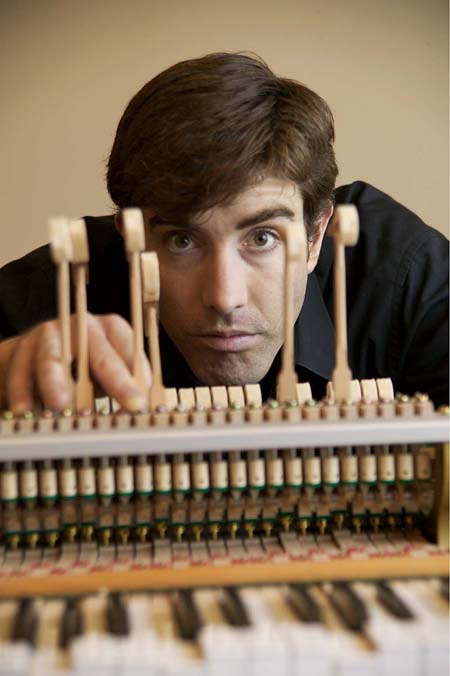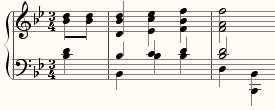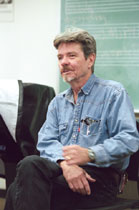The other day on New Music Box some guy, a young guy I presumed, characterized composers who write tonal music as having ignored all the progress made in the 20th century. That was certainly the kneejerk complaint my old-fart college professors were making in 1975 when minimalism first reared its diatonic head. It didn’t take too many years for the charge to get laughed out of court, so I’m always surprised to hear of someone still learning it in school now – like those Japanese soldiers stranded on desert islands who went months without hearing that World War II had ended.
The new course I’m teaching that I wrote about recently is titled “Progress Versus Populism in 20th-Century Music.” It describes classical and postclassical music since 1913 as racked between two contradictory convictions. One is the idea that music should continually increase in subtlety and sophistication, each new generation learning everything that came before and moving continually forward in a linear evolution. The other is the idea that music not understandable by untrained listeners is elitist and therefore politically suspect; that by appealing only to the super-educated it marginalizes itself and becomes safe, soaking up cultural resources without doing anything to break down the advantages that the elites – financial, corporate, cultural, and otherwise – have over the common man.
Notice that these two convictions do not directly contradict each other. The belief that music should continally become more subtle and complex – though where that “should” acquires its moral force is difficult to ascertain – does not deny the proposition that complex music removes itself from the sphere of political action. One can believe that music should remove itself from political action. But the way I’m characterizing the first two thirds of the century is that, for those decades, the contradiction seemed unresolvable. In 1933 – which, as a historian, I see as the year of the century’s most abrupt and diametrical change in musical attitudes, at least in America, the year that the repercussions of the stock market crash began to affect American lives in a widespread way – the idea of writing complex, dissonant, increasingly shocking music became about as totally discredited as an aesthetic attitude can become. It became “self-indulgent.” Every American composer who continued writing in the Depression simplified his or her style to reach out to the masses, starting with Copland’s El Salon Mexico. Some of the composers most committed to modernity, like Crawford, Rudhyar, Varèse, and Arthur Berger, temporarily ceased composing. Others, like Cowell, Antheil, and John Becker, felt forced to switch to an undistinguished conservatism. Those who managed to simplify their styles without weakening their music (or who were already writing simple music anyway), like Copland, Thomson, Barber, and Harris, took over the lead. Interestingly, Soviet composers of the same era had the exact same change forced on them by governmental fiat. Later, after the next war led to an era of financial prosperity, between 1948 and 1960, a tremendous countercharge swung the pendulum back toward complexity and increasing sophistication, in both America and Europe.
In any case, it seemed a foregone conclusion in those post-1920s decades that one could not be both politically and musically progressive. One either believed in participating publicly in musical life by writing music for the masses or in retreating from public presence by writing the most sophisticated music possible and hoping that society would eventually catch up. Political convictions and musical aspirations became extremely difficult to reconcile.
Around 1960, however, an interesting new possibility seemed to open up – at least that’s the way a lot of composers I know saw it. Minimalism, at least once its early, noisy, austere phase was over (by 1967), was certainly a move toward widespread understandability. It also made claims in terms of musical progressivism. The “metamusic” in those early Steve Reich pieces began to elicit subtle new listening modes not known before. Process pieces by Philip Glass and gradually retuning continua by Phill Niblock stretched musical perception – just as serialism had stretched musical perception, though in a different direction, one not closed off to the lay listener. Many composers, like this guy at New Music Box, denied that returning to pitch simplicity in any respect constituted a perceptual stretch. I remember a friend saying circa 1974 that he liked what Reich was doing in Piano Phase, but wished he had used more dissonant pitch sequences to make the point. For many of us, however, that phase of minimalism from 1967 to 1979 created a whole new perception of how music could be progressive and increasingly sophisticated without being elitist. Then Glass wrote Satyagraha and Reich wrote Desert Music, and those who saw minimalism as musically regressive seemed, for awhile, to have won their point.
But the seed had already been sown. For a lot of (you will excuse the term) Downtown composers, that 1964-to-1979 phase of minimalism was the movement’s only creatively exciting phase. By 1983, a small segment of the generation born in the ’50s had begun developing minimalist ideas in the direction of greater sophistication. Limitation of harmonic materials (either consonant or dissonant, it hardly mattered) allowed an increased focus on more interesting kinds of aural illusions. Rhythmic dissonance and formal process appeared to be more fertile avenues of new perception than intricately convoluted pitch structures. Elliott Carter-type rhythmic complexity, with no beat-grid to hear it against, seemed tame compared to beats at different tempos running at the same time. Though left in the lurch by minimalism’s subsequent development, we felt emboldened to believe that one wasn’t forced to choose between political and musical progressiveness. Employing electric guitars, drum beats, and other materials borrowed from pop music in processes derived from Nancarrow and the unrealized visions of Henry Cowell, we felt we could have it both ways at once.
And that will be the surprise ending of my course: that it just might be possible that the “versus” in “Progress versus Populism” can eventually be dissolved away.
Of course, the progress made by the totalists (as some of us call the rhythmically complex/harmonically simple composers who tried to have their cake and eat it too) has been ignored by the great majority of composers, who either never recognized the inherent political pitfalls of elitism or took a defeatist attitude toward them. And that’s the great tragedy – that the decisions get made by composers rather than by the public. The corporate dictatorship unleashed by Reagan’s policies drew a curtain between newly evolving music and the wider public, with the result that by the late 1980s we found that the audience for new music primarily consisted of fellow professionals – other composers.
Personally, I don’t write my music for composers. I don’t expect other composers to appreciate my music, and most don’t. There is no way I could impress, or would want to impress, composers superficially trained to make a kneejerk association of pitch complexity (even the watered-down, New Romantic type) with forward-looking musical thinking. The number of composers whose taste I trust enough to learn anything from their reactions to my music is relatively tiny – I could name them in a brief paragraph. Yet I learn tons from the reactions of colleagues in other fields, from unbiased listeners, from students, from nonmusicians who come up to me after concerts. Unfortunately, those people – whose perceptions I deliberately aim to expand and seduce, and who frequently express delight with what I’m doing – are not the people making decisions about what music gets supported. The world of new composition, of commissions and awards and grants that make creative work possible, is run by composers, the vast majority of whom have ignored the types of progress made by my kind of music, and who oppose its dissemination.
That’s been the tragedy of new music for more than 20 years. We invented a new music that we thought would create a new audience. Then our potential for influencing any mass audience (which Cardew accurately notes is the composer’s true means of production) was taken away by the corporate elites. It’s extremely difficult for us to understand how so many composers can cling to a musical elitism that is precisely analogous to the corporate, financial, and cultural elitism that keeps new music out of the public ear. That false conception of “musical progressivism” does seem tied to political regress, to an ultimately right-wing notion that only the experts should be in control. Society doesn’t need to “catch up” with our music – it only needs to hear it. And the composers commited to elitism, who would rather consolidate their power within the professional institutions than by eliciting love and admiration from audiences, prevent audiences from hearing it – on the grounds that it “ignores all the progress made in the 20th century.” It looks to me like they’re the ones ignoring the progress.



 The great James Tenney died last night [actually, the night before, August 24]. Word went around a few weeks ago that his old lung cancer had returned after a long remission of many years. He was a great teacher, great drinker, great companion, and an interestingly odd personality. As a composer he was a kind of hard-core conceptualist driven by theoretical curiosity. As a result his music could be awfully dry at times, but in about half of it or more the conceptualism transformed in kind of an amazing alchemy to an extreme sensuousness, lovely, slow sound-metamorphoses that you just couldn’t believe. I’ll repeat here what I said about him in American Music in the Twentieth Century:
The great James Tenney died last night [actually, the night before, August 24]. Word went around a few weeks ago that his old lung cancer had returned after a long remission of many years. He was a great teacher, great drinker, great companion, and an interestingly odd personality. As a composer he was a kind of hard-core conceptualist driven by theoretical curiosity. As a result his music could be awfully dry at times, but in about half of it or more the conceptualism transformed in kind of an amazing alchemy to an extreme sensuousness, lovely, slow sound-metamorphoses that you just couldn’t believe. I’ll repeat here what I said about him in American Music in the Twentieth Century: